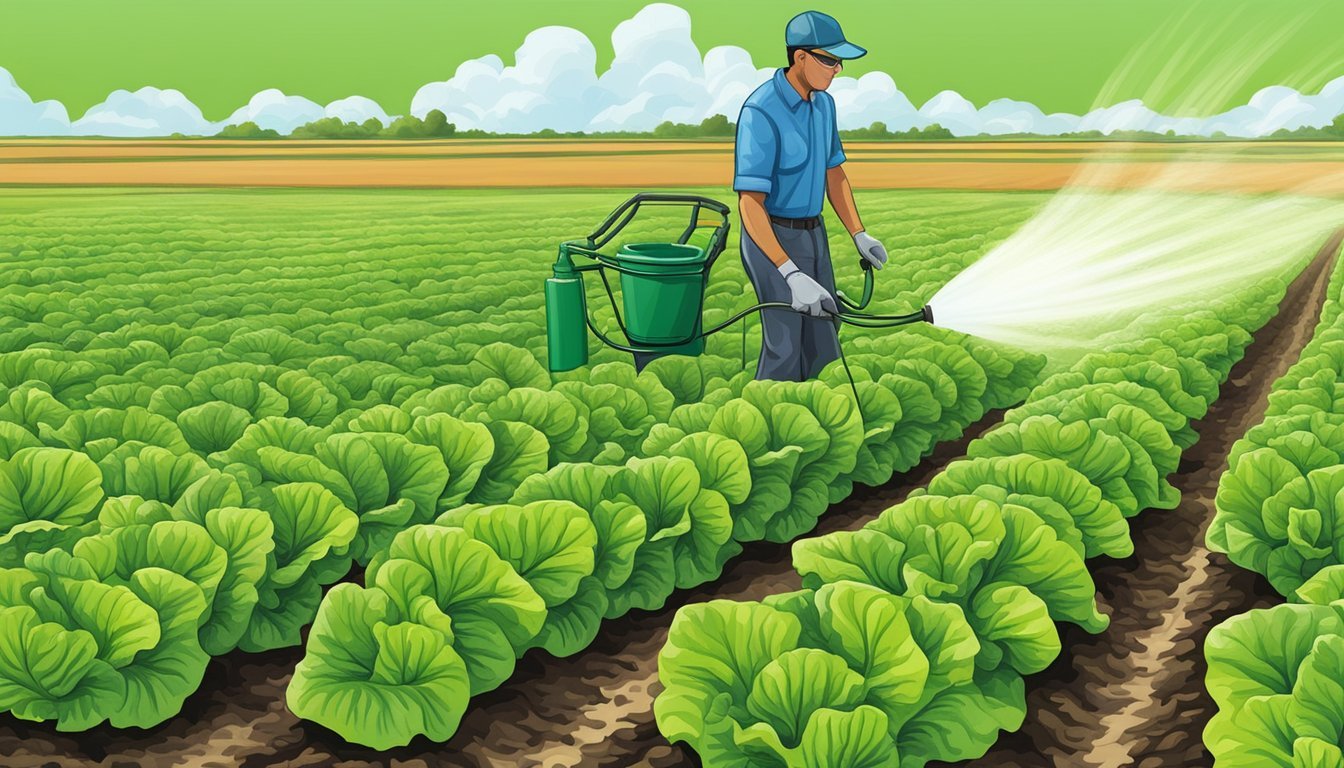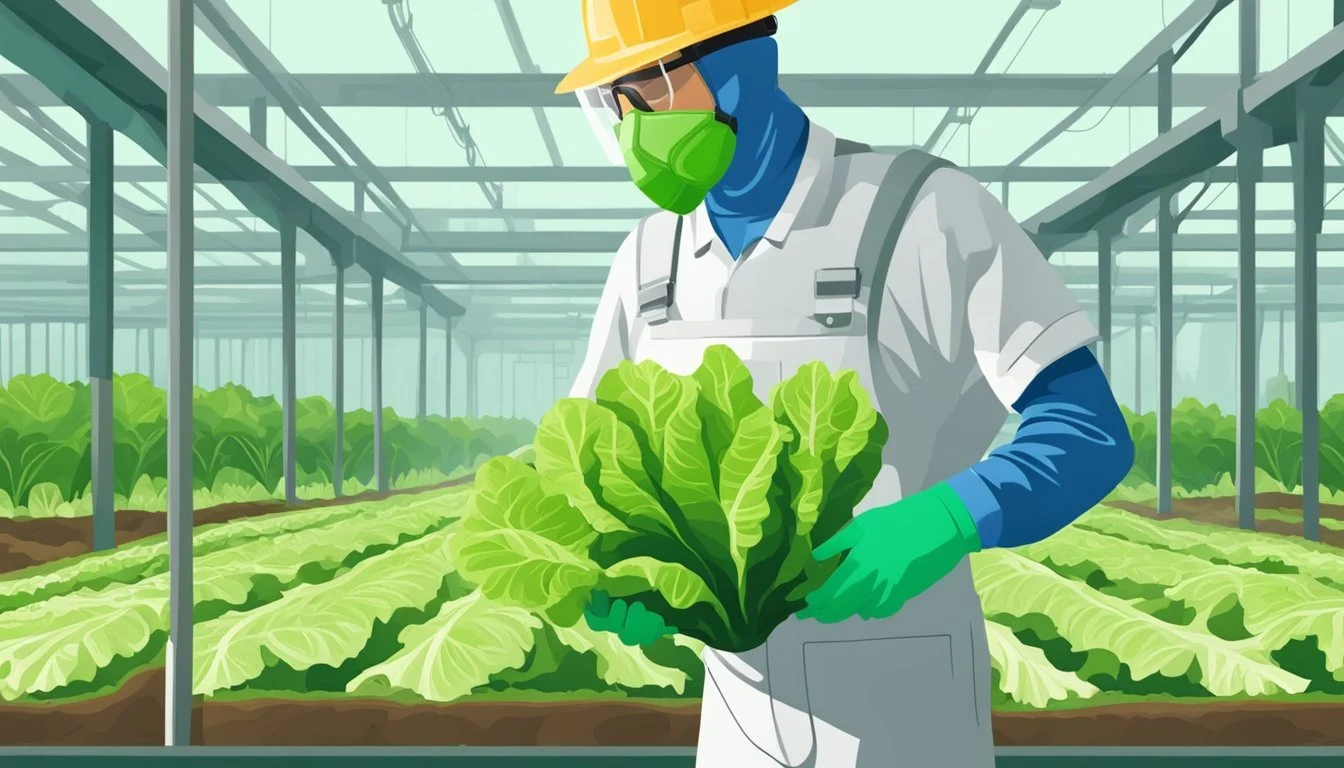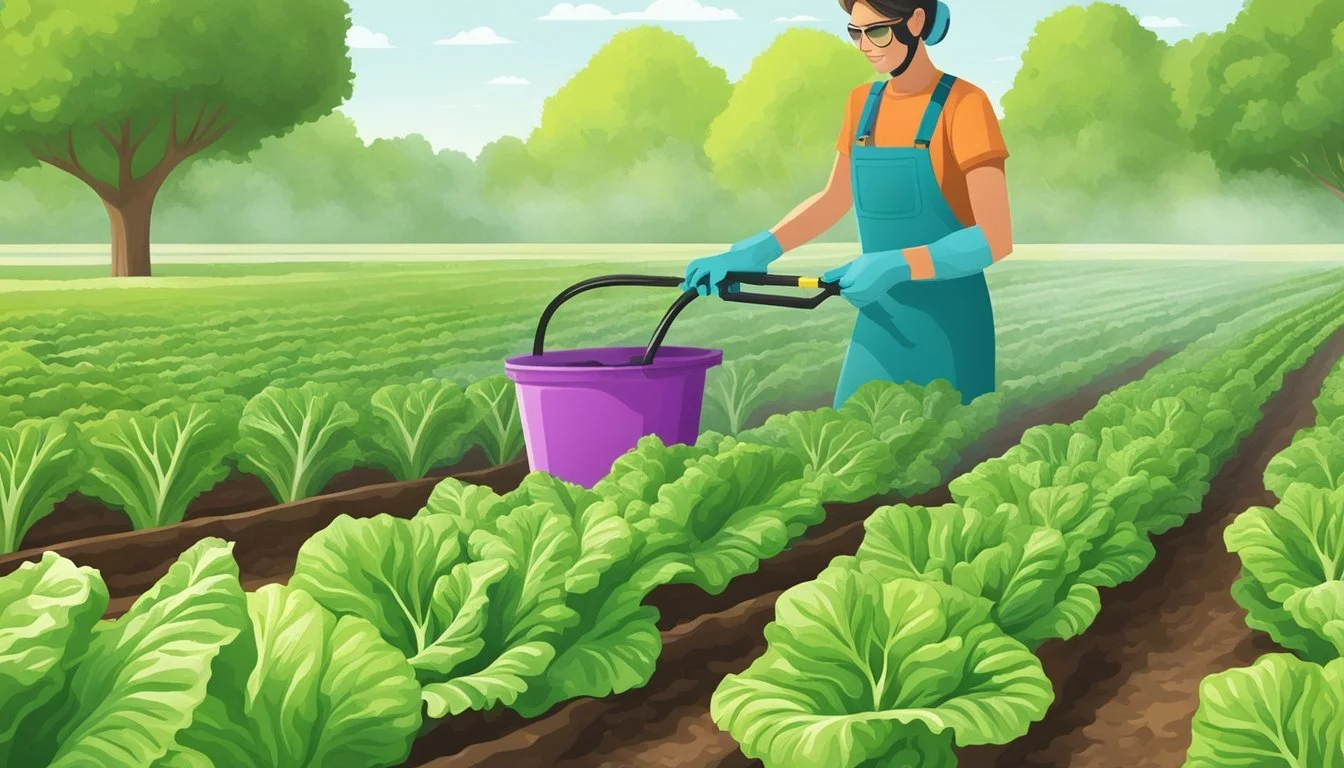Pest Control for Romaine Lettuce
Effective Strategies for Healthy Crops
Romaine lettuce, also known as cos lettuce, is a popular leafy green vegetable known for its crunchy texture and nutritional value, making it a staple in salads and wraps. Cultivating romaine lettuce necessitates not only attention to soil and water but also a vigilant approach to pest control. Pests can pose a significant threat to the health and yield of romaine lettuce crops, which is why understanding and implementing effective pest control measures is essential for gardeners and commercial growers alike.
Common pests that afflict romaine lettuce include aphids, slugs, snails, and caterpillars, among others. These pests can damage the leaves, transmit diseases, and ultimately compromise the quality of the harvest. Effective pest control involves a combination of monitoring, preventive measures, and, when necessary, the application of control methods that are safe for both the plants and the environment. It's crucial to identify the type of pests present in order to choose the appropriate control strategy and ensure the continued production of healthy, crunchy romaine lettuce for consumption.
Understanding Lettuce Pests
Managing pests is crucial for the health of romaine lettuce. A variety of insects can target the tender leaves, leading to significant crop damage. Identifying these pests and understanding their behavior are essential steps in effective pest control.
Types of Common Lettuce Pests
Aphids: These small, soft-bodied insects often appear in clusters, sapping nutrients from leaves.
Cutworms: These caterpillar larvae attack young plants, severing them at the base.
Slugs and Snails: These mollusks chew irregular holes in leaves, preferring moist conditions.
Caterpillars: Various species, such as the cabbage looper, consume large portions of foliage.
Beetles and Thrips: Beetles can defoliate plants, while thrips cause discolored patches.
Armyworms and Flea Beetles: Armyworms can devour entire plants, and flea beetles create small holes in leaves.
Whiteflies: These tiny insects congregate on the undersides of leaves, feeding on plant juices.
Recognizing Signs of Infestation
Irregular Holes: Caused by slugs, snails, and beetles.
Distorted Leaves: Often indicative of aphid or whitefly activity.
Silvery Trails: A telltale sign of snails or slugs.
Chewed Stems: Typically the result of cutworm or caterpillar feeding.
Role of Natural Predators
Lacewings: Feed on aphids and other soft-bodied insects.
Parasitic Wasps: Lay eggs in or on pests, ultimately controlling their populations.
Lady Beetles: Known for their appetite for aphids and other small insects.
Lettuce Diseases and Associated Pests
Downy and Powdery Mildew: Fungal diseases that thrive in damp environments, often facilitated by insects.
Bacterial Leaf Spot: Caused by bacteria and sometimes spread by insects.
Mosaic Virus: A disease that can be transmitted by aphids and leads to mottled leaves.
Bottom Rot and Leaf Spot: Conditions linked to high humidity and certain soil-borne pests.
Cultural Control Methods
Implementing cultural control methods in lettuce cultivation focuses on strategic garden maintenance, plant selection for pest resistance, and employing precise irrigation techniques. These practices aid in deterring garden pests and reinforce preventive measures, which is essential for producing healthy salads.
Garden Maintenance Practices
To curtail pest infestations in romaine lettuce, garden maintenance plays a critical role. Crop rotation can significantly hinder the life cycle of pests and diseases that favor particular crops. Introducing companion plants such as nasturtiums, begonias, fuchsias, geraniums, lavender, rosemary, and sage can repel pest insects or attract beneficial predators that feed on pests. Additionally, maintaining cleanliness by removing plant debris and weeds that can shelter harmful insects is imperative for a pest-resistant garden.
Plant Selection and Diversity
Choosing the right varieties of Romaine lettuce is essential for pest management. Varieties with inherent resistance to specific pests and diseases can immensely reduce the need for chemical interventions. Incorporating a diverse set of plants within the garden can also hinder pest proliferation by creating a less homogenous environment that's less appealing to pests that prefer romaine lettuce.
Proper Irrigation Techniques
Pest populations can be directly affected by the way a garden is watered. Employing drip irrigation can contribute to optimal moisture levels for romaine crops while keeping the foliage dry, which is less attractive to certain pests. Also, watering at the ground level prevents splashback of soil, which may contain disease spores. The timing and amount of water applied are crucial for preventing excessive humidity, which can promote the growth of molds and fungus, detrimental to lettuce.
Implementing these cultural control methods not only helps to manage pests in a sustainable way but also reduces the reliance on chemical pesticides, promoting a healthier garden ecosystem for romaine lettuce production.
Mechanical and Physical Control Strategies
In managing pests in romaine lettuce crops, mechanical and physical control strategies offer an environmentally friendly and often immediate solution to some common garden pests such as cutworms and aphids.
Manual Removal
The most straightforward approach to pest control is manual removal. Gardeners, equipped with gloves, can handpick pests such as snails, crickets, and larger insects directly off the plants. For smaller pests like aphids, regular inspection of the lettuce leaves and stems can allow for the early detection and removal by rinsing with a water hose or wiping with a cloth.
Barriers and Traps
To prevent insects from reaching the lettuce, physical barriers such as floating row covers can be employed. These barriers not only keep out unwanted pests like cutworms but also create a physical obstacle for flying insects such as aphids. Another effective strategy includes setting up traps; yellow sticky traps are particularly good for luring and capturing aphids and whiteflies that are drawn to the color.
Tillage Practices
Tillage practices contribute significantly to pest management in lettuce cultivation. By turning the soil before planting and after harvesting, growers can disrupt the life cycles of pests like nematodes and soil-borne insects. Crop rotation is an important tillage practice that minimizes the risk of pest buildup by alternating the types of plants grown in a particular area, thus reducing the long-term presence of specific garden pests.
Biological Pest Control Options
In managing pests that affect romaine lettuce, biological controls offer a sustainable approach by leveraging natural predators and biological agents to reduce pest populations.
Introducing Beneficial Insects
Lacewings: These insects are invaluable allies in the garden, particularly for their larvae, which consume large numbers of soft-bodied pests, such as aphids, which commonly affect romaine lettuce. Introducing lacewings into the crop environment can help keep aphid populations in check.
Lady Beetles: Often recognized as the classic beneficial insect, lady beetles (or ladybugs) feed on a variety of pests that plague romaine lettuce. By releasing these beetles into the crop, growers can effectively control pest populations without resorting to harsh chemical pesticides.
Utilizing Insect Parasites and Pathogens
Parasitic Wasps: Tiny but mighty, parasitic wasps lay their eggs inside or on the surface of host insects, ultimately controlling pest populations as the wasp larvae develop. They are particularly effective against caterpillars and other larvae that damage lettuce leaves.
Bacillus thuringiensis (Bt): This soil-dwelling bacterium produces proteins that are toxic to specific insects when ingested. Applying Bacillus thuringiensis as a foliar spray can help control caterpillar pests without harming beneficial insects or the environment.
Nematodes: Beneficial nematodes can be released into the soil where they infect and kill various soil-dwelling pests. These microscopic roundworms are effective against larvae of pest insects that have soil phases, ensuring protection for the romaine lettuce roots.
Chemical Control Measures
Effective management of pests that affect romaine lettuce involves a variety of chemical control measures. These measures can safeguard lettuce leaves from insect damage and disease. It is essential to understand the different types of pesticides available and their application techniques to ensure both efficacy and safety.
Organic Pesticides
Organic pesticides, while naturally derived, can be potent against pests. Neem oil and spinosad are two common organic options for controlling sap-feeding insects and caterpillars. Neem oil functions as both a repellent and a growth regulator, whereas spinosad is hailed for its ability to combat a wide range of pests while being relatively safe for beneficial insects. Another organic compound, azadirachtin, is effective in disrupting the life cycle of numerous insects. When applying organic pesticides to romaine lettuce, it is imperative to follow label directions for dosage and timing.
Synthetic Pesticides and Resistance Management
Methoxyfenozide is a synthetic pesticide that specifically targets lepidopteran larvae, which can be devastating to romaine lettuce. Its selective action preserves beneficial insects while controlling harmful pests. To prevent the development of pesticide resistance, it is advised to rotate between methoxyfenozide and other pesticides with different modes of action. Implementing resistance management strategies ensures long-term control of lettuce pests and maintains the viability of chemical control measures.
Spray Application Techniques
Effective spray application is crucial for the success of both organic and synthetic pesticides. Proper techniques involve the uniform coverage of lettuce leaves, ensuring that the underside, where pests often reside, is not neglected. Horticultural soap can be added to pesticide mixtures to enhance spread and adherence on leaf surfaces. The timing of applications is also significant; treatments are most effective when conducted in the early morning or late evening to minimize the impact on pollinators and to avoid rapid evaporation.
Using these methods, one can address pest issues in romaine lettuce cultivation with precision, reducing the likelihood of extensive damage while adhering to safety and environmental standards.
Integrated Pest Management (IPM)
Integrated Pest Management is a holistic approach that combines multiple strategies to manage pests effectively. Employing preventive measures, biological, cultural, mechanical, and chemical controls, IPM targets lettuce pests, including insects, bugs, and diseases, while reducing harm to the environment.
Monitoring and Identifying Pests
Regular monitoring is the cornerstone of IPM for romaine lettuce. This involves detailed inspection of lettuce crops for early signs of pest presence. Accurate identification of pests is vital because different pests require specific management strategies. Tools like pheromone traps or sticky cards are often used to monitor insect populations, while visual inspections can identify damage patterns indicative of specific pests or diseases.
Insects: Caterpillars and aphids are commonly found attacking lettuce crops.
Diseases: Bacterial leaf spots and downy mildew might also pose a threat.
Threshold Levels for Action
IPM operates on the principle that not all pest presence warrants intervention. Action thresholds are established levels of pest populations or damage, at which point control methods are implemented. These thresholds are carefully designed to prevent economic loss from pest damage while avoiding unnecessary interventions.
Preventive Measures: Crop rotation and sanitation can help prevent the outbreak of pests.
Biological Controls: Introducing beneficial insects, like ladybugs, can control aphid populations naturally.
Cultural Control: Proper field spacing and irrigation practices reduce conditions favorable to pest proliferation.
Mechanical Control: Manual removal, barriers, and tillage can contribute to pest management.
Chemical Control: Application of pesticides remains an option but is used as a last resort, with careful consideration of the impact on non-target organisms and resistance development.
Home Remedies and Natural Treatments
Controlling pests on romaine lettuce requires attention to non-chemical methods. Home remedies and natural treatments offer a safe and eco-friendly option to prevent and control infestations.
Common Household Solutions
Gardeners can combat lettuce pests like aphids and snails using everyday household items. For example, a solution of dish soap and water can be effective in removing pests from plants. Pour a teaspoon of dish soap into a quart of water and spray onto infected areas. To target snails and slugs, cinnamon can be sprinkled around the base of the lettuce plants, as its scent acts as a natural repellent.
Organic Bait and Repellents
Organic bait and repellents work without the use of harsh chemicals. Create a bait for snails using a shallow dish filled with beer, which attracts and then drowns them. Organic repellents can include barriers such as crushed eggshells or diatomaceous earth spread around the lettuce. The sharp edges deter snails and other soft-bodied pests. Additionally, rubbing alcohol, when diluted with water, can be sprayed on lettuce leaves to control aphid populations.
Companion Planting Benefits
Companion planting provides numerous benefits for romaine lettuce by repelling pests naturally. Some flowers, such as nasturtiums, begonias, fuchsias, and geraniums, exude scents that are unattractive to many pests who would otherwise feast on lettuce. Moreover, aromatic herbs like lavender, rosemary, and sage can also serve as deterrents. Planting these companions nearby can create a protective barrier, giving a boost to the garden's overall health.
Preventive Practices for Garden Health
Effective management of romaine lettuce pests begins with preventive strategies that promote garden health and mitigate pest-related issues. This proactive approach focuses on maintaining soil quality, implementing crop rotation, and keeping the garden clean.
Soil Health and Nutrition
Healthy soil is the foundation of a vigorous garden. A well-nourished soil promotes robust lettuce crops that are more resilient to pests. Gardeners should test soil regularly and amend it with organic matter to maintain a balanced nutrient profile. It's important to ensure adequate levels of nitrogen and potassium, as these are crucial for lettuce growth. Furthermore, calcium is vital to prevent tip burn, which can make lettuce more vulnerable to pests.
Crop Rotation and Diversity
Rotating lettuce with non-related crops each year is a cardinal rule for preventing disease and disrupting the life cycles of many lettuce pests. Crop rotation helps reduce the buildup of pathogens and pests that could otherwise thrive if the same crops are planted continuously in the same location. Introducing a diverse assortment of plants creates a less attractive environment for pests and can even attract beneficial insects that prey on common lettuce pests.
Sanitation and Weed Management
Good garden hygiene is a key line of defense against pests. Removing plant debris and fallen leaves promptly can greatly diminish habitat for pests like slugs and aphids. Managing weeds is also critical because they can harbor pests and compete with lettuce crops for nutrients and light. Keeping the garden tidy and free from unnecessary plant material lessens the chances for pests to establish themselves and threaten your salads.
Post-Harvest Pest Management
Post-harvest pest management for romaine lettuce is essential to maintain the quality of the produce during storage and transportation. Specific techniques and regular inspections are key to preventing infestations that can compromise the safety and aesthetics of lettuce destined for fresh salads and wraps.
Handling and Storage Techniques
Proper handling and storage are vital for keeping post-harvest pests at bay. To minimize the risk of infestation, one should adhere to the following protocol:
Temperature Control: Maintain a constant, cool temperature to inhibit pest activity, as pests are less active in colder environments.
Humidity Management: Ensure that humidity levels are optimal to discourage pest proliferation without causing the lettuce to wilt.
Sanitation: Keep storage areas clean and free of debris where pests can breed.
Packaging: Use pest-resistant packaging material that limits the potential for pest entry.
Inspection and Monitoring for Transportation
Inspection and monitoring protocols during transportation are equally critical to ensure the integrity of romaine lettuce:
Pre-Loading Check: Inspect the transportation vehicle for cleanliness and signs of pest presence before loading the produce.
Regular Monitoring: Check the lettuce at regular intervals for any signs of pest activity. If pests are detected, actions such as refrigerating the produce at a lower temperature or segregating affected produce may be taken.
By implementing these strategies diligently, one can effectively manage post-harvest pests and ensure that romaine lettuce remains fresh and appealing for consumers.
Frequently Asked Questions
In managing pests that compromise the health and yield of romaine lettuce, gardeners often seek effective strategies. This section addresses common concerns, providing actionable insights into the prevention and control of pests specific to romaine lettuce.
What natural remedies can protect romaine lettuce from pest infestations?
Integrating plants like nasturtiums and marigolds into the garden may deter pests due to their repelling properties. Creating barriers and traps can also combat slugs and snails, known for damaging lettuce.
How can neem oil be used in controlling pests on romaine lettuce?
Neem oil, when applied as a foliar spray, can act as a natural deterrent against aphids and other pests on romaine lettuce. It disrupts the life cycle of insects without harming beneficial pollinators when used correctly.
What are the common pests found on romaine lettuce, and how can they be identified?
Common pests include aphids, slugs, and caterpillars. Aphids appear as small green or black insects, often clustering on the underside of the leaves, while slugs and caterpillars can be spotted by the damage they cause and their visible presence on the plant.
Which pest control methods are considered the most effective for romaine lettuce?
Frequent monitoring, handpicking pests, and using floating row covers are effective strategies. Additionally, properly timed applications of organic pesticides like diatomaceous earth can offer protection without the use of harsh chemicals.
Are bugs commonly found in romaine lettuce harmful to humans?
While most bugs in romaine lettuce are not harmful to humans and do not pose a health risk if ingested, they can affect the quality and aesthetic of the lettuce, making pest control a priority for gardeners.
How can I prevent green bugs from damaging romaine lettuce?
Maintaining a clean garden, utilizing companion planting, and employing natural predators like ladybugs can help prevent infestations of green bugs on romaine lettuce. In some cases, organic sprays may be necessary for control.









